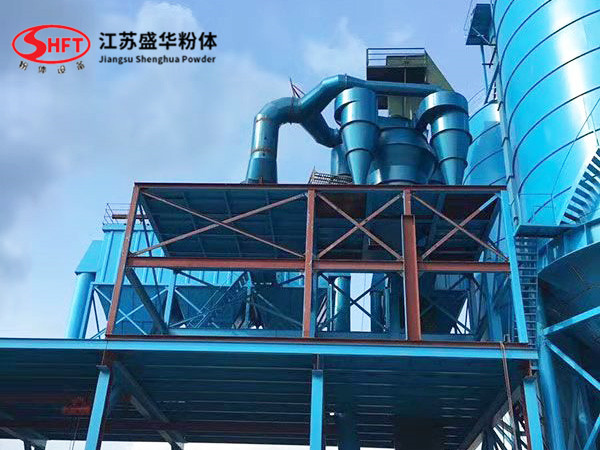-
tel: +8617802596658
-
email: shpowderseparator@gmail.com
-
Whatsapp: 8617802599580
Bauxite Powder Separator

Working Principle
The material enters from the feed pipe and is scattered into the rising airflow through the dispersion plate. The grinding medium fragments in the material overcome the resistance of the rising airflow under the action of gravity and fall down, and are discharged from the slag discharge port. The airflow carrying the powder rises to the classification part and enters the rotor through the guide vane for classification. The guide vane can make the airflow and powder particles produce a rotary motion for pre-classification, and capture the coarse particles thrown out by the rotor, and can also make the airflow speed evenly distributed over the entire rotor height. The coarse particles captured by the guide vane fall onto the coarse powder cone and are discharged from the coarse powder outlet, while the fine particles and the airflow pass through the rotor blades into the middle of the rotor and are sent to the collection device from the fine powder outlet.
Features
1. The material is dispersed outside the classification area. Due to the effects of the dispersion plate, the intermediate connecting air duct and the guide vane, it has both static inertial classification and dynamic classification functions, and the material dispersion is high and evenly distributed.
2. The separator classification area is narrow and long, the air flow field is balanced and stable, the classification performance is good, and the classification efficiency is high.
3. The separator has a large processing capacity, and with other separators, the volume can be made smaller under the same processing capacity.
4. Simple structure, long service life of wear-resistant parts;
5. Small air volume and small pressure difference loss;
6. The fineness of the finished product can be controlled by adjusting the wind speed, which is convenient and reliable;
7. It has a drying function;
Classification of bauxite separators
Separators are widely used in coal mills, raw material unloading drying mills and cement mill systems in new dry cement production lines. It can be divided into three categories: three-separation separators, centrifugal separators, and cyclone separators. There are many types of separators, and different types are suitable for different materials. Different models are also made according to customers' requirements for material fineness. Common separators include cyclone separators, three-separation separators, centrifugal separators, separators for coal mills, separators for calcium powder, etc. Later, many high-efficiency separators and high-efficiency three-separation separators were developed. They are new generation varieties that improve deficiencies and increase production on the original basis.
Common faults and troubleshooting of separator
(1) Gearbox heating or "smoking"
Cause: Gearbox lacks oil, poor lubrication, poor oil quality. Overloaded use. Transmission body failure.
Troubleshooting: Improve lubrication, add oil or change oil. Control load or improve transmission design. Analyze and treat according to "burning oil", "bonding", "thermoplastic deformation" and other specific problems
(2) Gearbox vibration and noise
Cause: Poor tooth contact surface. Side clearance is appropriate, axial movement. Bevel gear accuracy is out of tolerance.
Troubleshooting: Adjust the contact surface. Adjust the side clearance and eliminate the movement. Replace the bevel gear.
(3) Bevel gear root crack or break
Cause: Poor tooth contact surface. Side clearance is appropriate, axial movement. Bevel gear accuracy is out of tolerance.
Troubleshooting: Adjust the contact surface. Adjust the side clearance and eliminate the movement. Replace the bevel gear.
(4) Gear thermoplastic deformation and bonding
Cause: Poor lubrication, less oil, no oil. Overloaded use at high speed.
Troubleshooting: Clean the oil tank, change the oil and add oil. Control speed, control load or improve design
(5) Severe erosion and peeling of gears
Cause: Bearing clearance is too large, bearing wear is serious. Material or heat treatment is poor. Overload.
Troubleshooting: Repair or replace bearings. Improve material, improve heat treatment. Control load.
(6) Severe wear of gears
Cause: Poor protective seal. Poor oil quality, impurities in oil. Poor material.
Troubleshooting: Strengthen protective seal. Clean and change oil. Use wear-resistant material.
(7) Abnormal heating and noise of rolling bearings
Cause: Poor lubrication, lack of oil and serious wear. Flange bolts at the end of the horizontal shaft are loose and slipped. Loose fit and larger clearance. Upper adjustment nut thread slips
Troubleshooting: Add oil in time and increase oil volume for a short time. Re-tap and enlarge bolts. Dismantle and repair. Process the shaft head, re-thread, and replace nuts.
(8) Separator blades are damaged or dropped and the body swings
Cause: Poor blade quality and inconsistent weight. Loose blade fixing bolts. Improper installation, causing upward or downward deflection.
Troubleshooting: Replace the blades, weigh and install evenly. Check the bolts, tighten them with washers. Adjust the installation position.















